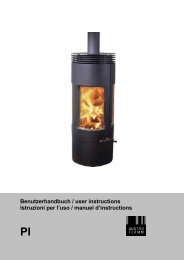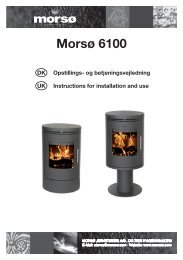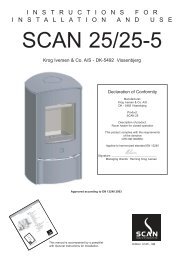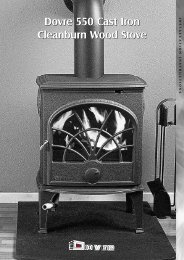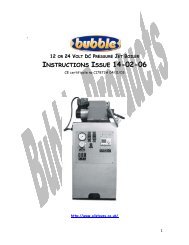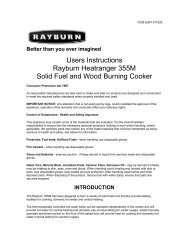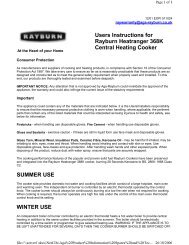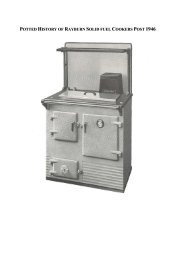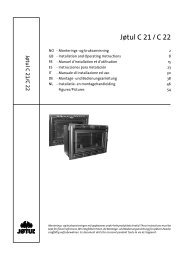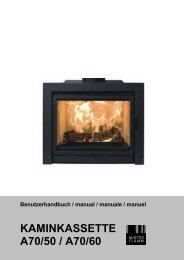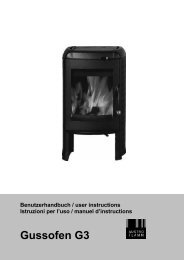Dovre 250 Cleanburn Cast Iron Stove - Stoves Online
Dovre 250 Cleanburn Cast Iron Stove - Stoves Online
Dovre 250 Cleanburn Cast Iron Stove - Stoves Online
You also want an ePaper? Increase the reach of your titles
YUMPU automatically turns print PDFs into web optimized ePapers that Google loves.
<strong>Dovre</strong> <strong>250</strong> <strong>Cleanburn</strong><strong>Cast</strong> <strong>Iron</strong> <strong>Stove</strong>Installation and Operating ManualPM150 Issue 1 (May 2005)Craftsmanship in <strong>Cast</strong> <strong>Iron</strong>
Unpacking your <strong>Dovre</strong> <strong>250</strong>Your <strong>Dovre</strong> <strong>250</strong> is constructed from high-grade quality cast iron and istherefore not light in weight. We recommend that 2 people areavailable to handle the stove.Care should be taken not to break the glass whilst handling theappliance.Before taking your <strong>Dovre</strong> to its installation location, remove the stovefrom its outer packing and timber pallet. Stand the stove in the uprightposition, protecting carpets or other floor coverings with rigidcardboard. The stove carton is ideal for this purpose.Locate the small green quality control slip and retain for futurereference.Getting the best from your <strong>Dovre</strong> <strong>250</strong>There are 3 golden rules to follow:1. USE GOOD FUEL - NEVER BURN UNSEASONED OR DAMP WOOD2. YOU MUST HAVE A GOOD CHIMNEY DRAUGHT - NEVERUSE YOUR DOVRE STOVE WITH A POOR CHIMNEY3. AVOID OPERATING THE STOVE FOR LONG PERIODS ONCONTINUOUS LOW TEMPERATUREUSING SMOKELESS FUELSYour <strong>Dovre</strong> <strong>250</strong> is capable of burning a wide variety of smokeless fuelsbut the availability of different fuels varies from area to area. Seekadvice from your local fuel merchant and try out different fuels bybuying in small quantities until you find the fuel best suited to your<strong>Dovre</strong>.THE USE OF BITUMINOUS COAL AND PETROLEUM BASED FUELS ISPROHIBITED.Location for InstallationThe location in which your stove is to be installed will of coursedepend on the chimney available. If you do not have a chimney, thereare a number of prefabricated flue systems available and your <strong>Dovre</strong>dealer will be pleased to offer guidance on the subject.Building Regulations must be observed when considering the locationof your <strong>Dovre</strong> <strong>250</strong>. More precise information can be found later in thismanual but it is important to ensure that a suitable hearth, complyingwith Building Regulations, is available.NEVER ALLOW A MECHANICAL AIR EXTRACTOR TO BE USED IN THEROOM OR ADJOINING ROOMS AS THIS COULD CAUSE THEAPPLIANCE TO EMIT SMOKE INTO THE ROOM.AssemblyFITTING THE FLUE CONNECTORIf your <strong>Dovre</strong> <strong>250</strong> is to be connected to the chimney via the top flueconnector, proceed as follows:• Apply a thin and even coat of fire cement to the flanges on theflue spigot and the circular flue blanking plate.• Attach the flue spigot to the top opening in the stove, using the2 nuts and bolts (M8 x 25CSK slotted) supplied.• Attach the circular flue blanking plate to the rear opening of thestove using the retaining bar and (M6 x 25) bolt supplied.• Ensure that both flue spigot and blanking plate are securelytightened and correctly sealed with the fire cement.If your <strong>Dovre</strong> <strong>250</strong> is to be connected to the chimney via the rear flueconnector, proceed as follows.• Apply a thin and even coat of fire cement to the flanges on theflue spigot and the circular flue blanking plate.• Attach the flue spigot to the rear opening in the stove, using the2 nuts and bolts (M8 x 25CSK slotted) supplied.• Attach the circular flue blanking plate to the top opening of thestove using the retaining bar and (M6 x 25) bolt supplied.• Ensure that both flue spigot and blanking plate are securelytightened and correctly sealed with the fire cement.TOP BAFFLEPLATEFIREBRICKREAR BURN PLATEOPERATING TOOLASHPANFig 2 - STOVE COMPONENTSLOG GUARD3
InstallationHEARTH & CLEARANCE REQUIREMENTSINSTALLATION AGAINST A WALLFor installation as a free standing unit e.g. against a wall. (See Fig 3).The minimum constructional hearth required is 840mm (33”) x840mm (33”)and the unit must not be placed less than 150mm (6”)from the back and sides of the hearth. The wall must be constructedfrom non-combustible materials and must be a minimum height of1200mm (48”). The required wall thickness will depend on thedistance between the back of the stove and the wall (A). If thisdistance is less than 50mm (2”), the wall should be at least 200mm(8”) thick. If the distance from the back of the stove to the wall isbetween 50mm (2”) and 150mm (6”), the wall thickness must be atleast 75mm (3”) thick. If single wall flue pipe is attached to theappliance, the pipe should be a minimum of three times its diameterfrom any combustible materials.INSTALLATION IN A FIREPLACE RECESSFor installation in an fireplace recess or inglenook:The distance the hearth must protrude in front of the appliance shouldbe a minimum of 300mm (12”).The minimum thickness of hearth (B) should be 125mm (5”) and thismay include the thickness of a concrete floor including hearth tiles. If ahearth is constructed and / or supported on timber, the timber shouldbe at least <strong>250</strong>mm (10”) away from the top surface of the hearth.If a timber mantel is installed, the distance from the stove body and /or any single skin flue pipe, if attached to the top of the stove, to themantel must be a minimum of 450mm (18”).Chimney ConnectionsCONNECTION FROM THE TOP OF THE APPLIANCEA non-combustible register plate should be fitted to the lower sectionof the chimney. (See Fig 4).125 mm diameter 316 grade 1mm thick stainless steel flue pipe orvitreous enamel pipe suitable for use with solid fuel appliances shouldbe used to connect the top spigot of the stove to the chimney orchimney liner. (See Fig 4). All connecting joints must be femalepointing up and joints should be properly sealed with fire cement. Ifthe chimney is not immediately above the stove, off set bends of either30 degree or 15 degree angles may be used. (See Fig 5). Try to avoidlong runs of pipe that are not vertical.CONNECTION FROM THE REAR OF THE APPLIANCEA non-combustible register plate should be fitted to the lower sectionof the chimney. (See Fig 6).150 mm diameter 316 grade 1mm thick stainless steel flue pipe orvitreous enamel pipe suitable for use with solid fuel appliances shouldbe used to connect the rear spigot of the stove to the chimney orchimney liner. All connecting joints must be female pointing up andjoints should be properly sealed with fire cement. If the chimney is notimmediately above the stove, off set bends of either 30 degree or 15degree angles may be used. Try to avoid long runs of pipe that are notvertical. Start by connecting a 90-degree or 45 degree “T” section tothe flue spigot at the rear of the stove.NEVER INSTALL HORIZONTAL PIPE RUNS OVER 150mm (6”)DIRECTLY OFF THE BACK OF THE STOVE.Fig 3. Fig 4.4
The ChimneyACCESS FOR SWEEPING CHIMNEYThe chimney should be checked and swept at least once a year and itis important to allow provision for gaining access to the chimney. Onmasonry chimneys, a standard soot door, obtainable from your <strong>Dovre</strong>dealer, can be used. On other factory made chimneys, it is importantto ensure an access cleaning door is provided. It is advisable to ensurethat the connecting flue pipe to the chimney has an access door fitted.An access door close to the appliance will also facilitate the use of achimney vacuum cleaner to ensure clean appliance maintenance.AIR SUPPLYYour <strong>Dovre</strong> <strong>250</strong> requires an air supply to the room. The air ventshould have a minimum air flow area of 110 sq.cm (17 sq inches).THE CHIMNEY(Minimum height requirement 4.5 metres (16 ft.)This is one of the most important aspects of the installation of your<strong>Dovre</strong> stove. It is important to ensure the following.CHIMNEY DRAUGHTDraught Requirement 1.5 to 2mm Wg.Too much draught will cause excessive heat outputs and fuelconsumption. Inadequate draught may cause smoke emission to theroom and poor combustion resulting in a build up of tar andcreosote deposits on the glass, inside walls of the appliance and thechimney.For existing chimneys, always ensure that the chimney is checked andswept prior to the installation taking place.MASONRY CHIMNEYSThe chimney must be sound, in good condition and must not beshared with another appliance. In the event of the chimney beingunlined, it is advisable to have a survey carried out to check for thepresence of leakage and other defects.Lining the chimney with a suitable 150mm (6”) diameter liner forwood burning and solid fuel burning applications, will improve theperformance and efficiency of the stove.THE ADVANTAGES OF A LINED CHIMNEY• With most unlined chimneys, the cross-section of the chimney isexcessive as in the case of large old inglenook fireplaces. Becauseof the large volume of cold air in large chimneys, it is difficult forthe flue gases to rise easily through the chimney. This causes theunburned volatile in the smoke to adhere to the chimney walls.• The inner surfaces of some unlined chimneys are rough withjagged edges causing difficulties in obtaining a good draught.• Unlined chimneys are often defective with cracks leaking fumesinto other parts of the house.• Larger, unlined chimneys, being cold, encourage the formation oftars (wood smoke condensation), which can penetrate the walls ofthe chimney leaving unpleasant black stains on internal plasteredwalls.PREFABRICATED CHIMNEY SYSTEMSIf a masonry chimney is not available, there are a number ofproprietary brand prefabricated flue systems available. Your <strong>Dovre</strong>Dealer will be pleased to offer information and advise on this subject.CHIMNEY TERMINALDown draught problems may be experienced if the top of thechimney is close to adjacent taller trees and / or buildings. Your <strong>Dovre</strong>Dealer will be pleased to advise on suitable anti down draught cowlsshould these conditions prevail.Provided that your <strong>Dovre</strong> <strong>250</strong> stove has been installed in accordancewith the above installation procedures, you should now be ready to‘light up’. (See page 6 to light your <strong>Dovre</strong> <strong>250</strong>).Fig 4. Fig 5.5
Operating your <strong>Dovre</strong> <strong>250</strong>If your <strong>Dovre</strong> <strong>250</strong> is finished in enamel, care should be taken to avoidknocks as the enamel surface could “chip”.Non-enamelled <strong>Dovre</strong> stoves have been treated with a hightemperature resistant protective paint, which produces an odour whenthe stove is new. We recommend that you leave a window openduring the first few hours of use while the paint is curing.CONTROLLING YOUR DOVRE <strong>250</strong>WOODBURNINGThere are two fundamental air controls on your <strong>Dovre</strong> <strong>250</strong>, the lowerspin wheel air control and the top lever air control.When using your <strong>Dovre</strong> as a woodburner, the top air control should begenerally left in the fully open position. If the top air control is left forlong periods in the closed position, the air wash system will notfunction and the glass will quickly discolour. The lower air controlshould only be opened when first lighting or re-fuelling with wood.Choose well seasoned hardwood logs 300mm (12”) in length and nogreater than 75mm-100mm (3” to 4”) in diameter, and a minimum oftwo years old.REMEMBER: THE DRYER THE WOOD THE BETTERWET UNSEASONED WOOD PRODUCES CREOSOTE AND TAR INTHE CHIMNEY AND CAUSES RAPID BLACKENING OF THE GLASSDOOR.SMOKELESS FUEL BURNINGWhen using your <strong>Dovre</strong> for burning smokeless fuel, the top air controlshould always be closed (lever pushed fully to the right) a couple ofminutes after re-fuelling. The lower air control should be opened whenfirst lighting or re-fuelling with solid fuel. The heat output and burningrate of solid fuel only is regulated by opening and closing the lower aircontrol.TO LIGHT YOUR DOVRE <strong>250</strong>• Open the lower air control wheel.• If burning wood, open the top air vent fully by sliding the leverto the left. (NOTE THE TOP AIR VENT SHOULD MOSTLY BECLOSED WHEN BURNING SMOKELESS SOLID FUEL).• Lay rolled up newspapers and small sections of wood(kindling wood) on the grate. Light the paper with a long taper. Ifkindling wood is not available, firelighters may be used with smallpieces of split wood laid on top of the firelighters.• Close the door but do not fully lock at this stage. The fire shouldnow start to burn fiercely and brightly. If this does not happen,check for chimney blockage.As soon as the wood is burning with a well-established heat, add 2 or3 logs or a small quantity of smokeless fuel and close the door tightly.After a further couple of minutes, if using wood, fully close the lowerair control and if using solid fuel, close the lower air control to thealmost fully closed position. For solid fuel burning, the lower air controlis used to control the burning rate of the fuel. (See left “Controllingyour <strong>Dovre</strong> <strong>250</strong>”).REMEMBER: FOR WOODBURNING - OPERATE YOUR DOVRE WITHTHE BOTTOM AIR CONTROL CLOSED.CONTROL THE BURNING RATE BY ADJUSTING THE TOPAIR CONTROL.FOR SMOKELESS FUEL BURNING - OPERATE YOUR DOVRE WITHTHE TOP AIR CONTROL MOSTLY CLOSED. CONTROL THEBURNING RATE BY ADJUSTING THE LOWER AIR CONTROL.Note: Try to avoid operating your <strong>Dovre</strong> <strong>250</strong> with the lower aircontrol fully open for long periods of time. Operating your stove in thismanner causes the stove to burn excessive amounts of fuel and couldlead to premature wear on the grates, fire bricks and baffle plate.OVERNIGHT BURNINGWOOD BURNINGBefore retiring to bed:• Ensure that there is a good hot base to your fire and fully load thefire with hardwood logs, ideally 300mm (12”) long with amaximum diameter of 100mm (4”).• Open the lower and upper air controls to allow the fire the fire toburn fiercely. After 2 or 3 minutes, close the lower air control fullyand close the upper air control to the “almost” fully closedposition.If you require your stove to be used the following morning, carry outthe following procedure:• Open the lower and upper air controls.• Using a poker, lightly rake the ashes in the stove, bringing any hotembers to the centre of the grate.6
• Place small sections of wood on the grate and close the stove doorto the “almost” closed position.• When the fire becomes established, add more fully and proceed asabove (See page 6 “To light your <strong>Dovre</strong> <strong>250</strong>”).SMOKELESS FUEL BURNINGBefore retiring to bed:• Empty the ashtray.• Load the firebox with smokeless fuel. Do not over-load. The top ofthe fuel bed should be below the front fuel retainer.• Fully open the lower control. After 2 or 3 minutes, close thelower air control fully. Ensure that the top air control is fullyclosed.If you require your stove to be used the following morning, carry out thefollowing procedure:• Open the lower air control.• Empty the ash tray.• Load the firebox with smokeless fuel. Do not over-load. The top ofthe fuel bed should be below the front fuel retainer.• Close the door securely and close the lower air control to therequired position.Care and MaintenanceCAUTION: IF THE APPLIANCE EMITS SMOKE INTO YOUR ROOM, ITIS NOT THE FAULT OF THE APPLIANCE. THERE WILL EITHER BE ASTRUCTURAL FAULT OR DESIGN FAULT IN THE CHIMNEY OR LACKOF VENTILATION IN THE ROOM.NEVER LET THE ASHPAN OVERFILLThere should always be a good air space between the top of theashpan and the underside of the grate. Failure to do this will causepremature deterioration of the grate and will make it difficult to emptythe ashpan. Your <strong>Dovre</strong> <strong>250</strong>MFR is equipped with a special gratemechanism which allows ashes to be riddled into the ashpan whilst thestove door is closed. The riddling control lever is situated on the lefthandside of the front of the stove above the ashpan door. Gentlymove the lever backwards and forwards to clear the grate of ash.DAILY MAINTENANCE• Empty the ash pan• Check and clean light stains from the glass. Wipe the door glassclean using a cloth and Stovax Glass Cleaner.WEEKLY MAINTENANCE• The fibre door gaskets around the inside edge of the doorsprovide an air tight seal. Check these regularly and remove any ashor wood particles gently with a soft brush.ANNUAL MAINTENANCEAt the end of the heating season, thoroughly clean the inside of thestove and adjoining flue pipe.Arrange for your chimney sweep to inspect and clean the chimney.Carry out the following checks and procedures:• Replace the door and glass gaskets• Check and replace any worn fire bricks as necessary• Check and replace the cast iron grate if necessary• Check, clean and replace the top baffle plate if necessarySTOVE BODYTo clean enamelled surfaces use a soft dry cloth. For painted surfaces,the stove body can be repainted or touched up using StovaxThermolac stove paint.GLASSYou may notice a build up of deposits on your glass, particularly if thestove has been used for long periods at low temperatures. A hot briskfire will normally cure this problem, but if the problem persists, checkthe quality of your wood and/or chimney. It is always recommended tofire your stove hard after an overnight burn. From time to time, theglass can be cleaned using Stovax stove glass cleaner. Never useabrasive pads, or clean the glass when hot.To remove the ashpan open the door and carefully remove the ashpanusing the handle tool provided. Ashes must be disposed of carefullyand it is a good idea to purchase a Stovax Ash Caddy.After replacing the empty ashpan in the ashpan compartment, ensurethe ashpan door is fully closed.7
Managing your wood suppliesIf you are buying wood from a log merchant, try to ensure that thewood has been seasoned for at least 2 years. 3 years is even better. Thewood should preferably be cut to lengths of 300mm (12”) and split toa width of between 50mm and 100mm (2”- 4”).Store the wood under cover to protect from rain but ideally the woodshould be stored in a place where the wind will be allowed to freelyventilate the sack.Try to obtain hardwoods such as oak, elm, beech or ash. These woodswill provide more calorific value per cubic metre than softwoods.Trouble ShootingSMOKE EMISSIONIf smoke occurs when the stove door is opened, it is a sign that the fluedraught is inadequate. Mostly, burning unseasoned wood causes thiscondition and it usually indicates that the combustion temperaturesare too low. To overcome a weak draught, ensure your wood is dryand build a hot fire, leaving both air controls in the fully open position.If the problem persists, arrange for your chimney to be expertlychecked for design and contstruction faults. In some instances, downdraught conditions will exist and it may be necessary to fit an antidown draught device to the top of the chimney.Five Year WarrantyIf the castings on this appliance should prove to be defective withinfive years of the purchase date, the faulty castings will be replaced freeof charge, subject to the following conditions:1) The purchaser shall complete the registration card enclosed andreturn it within seven days of purchase. Failure to return theregistration card could result in delays in processing any claims.2) The appliance shall have been installed in compliance with theinstallation instructions and current Building Regulations.3) The appliance shall not have been used for the burning ofunseasoned wood and/or prohibited fuels.4) This warranty only applies to the appliance body castings and doesnot include renewable components including grates, ashpans, andglass, seals, baffle plates and chips on enamel castings.5) This warranty does not cover site visits and any claims should benotified to your dealer.This warranty does not affect your Statutory Rights.FIRE DOES NOT BURN FOR LONG PERIODSWood can contain a number of variable factors related to species,weight, age and moisture content. It is therefore difficult to be precisewith regards to the length of burn time.If it is thought that the fuel is burning too quickly:-• The diameter of the logs is too small.• If softwoods are used, change to using hardwoods.• Excessive chimney draught. If so, fit a draught stabiliser.• Worn out door and glass seals need replacing.Always try to avoid running your stove for long periods of time withthe air controls closed. This point is particularly important if the woodis not well seasoned. Failure to do so, will cause the glass, stove walls,and chimney to become soiled with tar deposits.United Kingdom and Eire distributors for <strong>Dovre</strong>:Stovax Limited, Falcon Road, Sowton Industrial Estate, Exeter, Devon, England, EX2 7LF.Telephone: (01392) 474011 Fax: (01392) 219932E-mail: dovre@stovax.com Internet: www.dovre.co.uk




